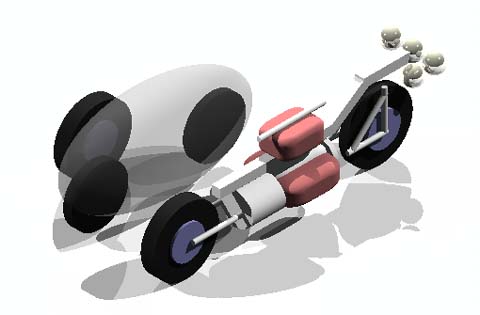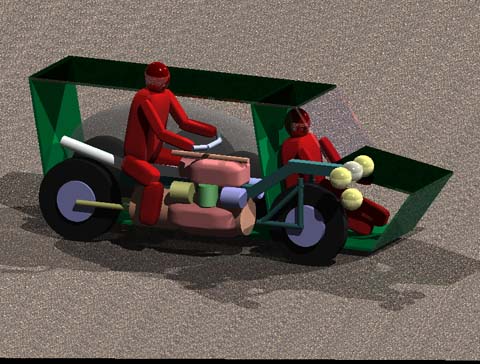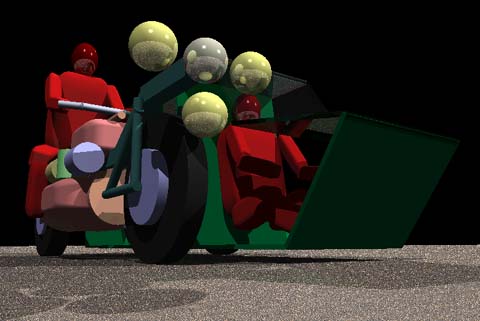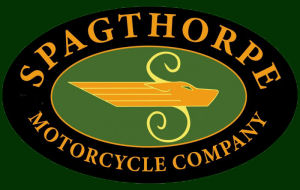|
B.
N. G. Spagthorpe:
Pit Bull/Rhino

Concept Illustration
with R75 for scale.
Jim Buchanan provided
us with this most loving description of the Spagthorpe Pit Bull:
Well, last weekend
I did it. I got the Britbike I’ve been wanting. I was picking up
some papers for recycling from my wife's aunt Tabitha. When I went
into the garage to get the papers, there it was, a Spagthorpe, with
a factory sidecar. I didn’t even know what model it was, but I
had to have it. When she saw how interested I was, Kris's aunt
explained that it had belonged to her late husband, and that I could
have it if I took good care of it. Wow!
She hasn’t
been able to find the title, and I’m still not quite sure what
model and year it is. It appears to be from the early eighties. Naturally,
my first thought was to ask on the ’net. Of course, I have some
technical questions as well.
On the upper fuel
tank there is a badge with a picture of a rhinoceros, so I suspect that
it is a Rhino. Of course, the tank from a Wolfhound would fit too from
the looks of it, so perhaps this doesn’t prove much. A friend of
mine says that the Rhino’ is just a re-badged Pit-Bull. Apparently,
sometime in the early ’80s a rider was mauled by the layshaft of
his Pit-Bull, and this plus the reputation of th canine of the same
name, and the litigious nature of the US, led the importer to re-badge
all Pit-Bulls as Rhinos’.
The engine is a
flat, opposed seven (the place where the eight cylinder would go is
taken up by the reciprocating power-steering pump). Estimating the bore
and stroke, I’d guess that the engine displaces about 2.6 liters.
In a novel twist
on turbocharging, there is a six cylinder reciprocating external-combustion
engine above the main engine. This is powered by the exhaust of the
lower, main engine. The output of this second engine is used to run
a unique scroll-shaped positive-displacement supercharger. This blower
resembles a rotary steam engine made around the turn of the century,
which I saw at the Giles Peach museum in Detroit a few years ago.
The engine is fuel
injected. There is an injector at each intake port (note: 4 of the cylinders
have two valves and one intake port, 3 of them have 4 valves and two
intake ports, I assume this is to broaden the torque curve, like most
Spagthorpe tourers, this is a fairly heavy bike). These injectors are
connected, via stainless-steel braided lines, to what can best be described
as "fuel distributors". There is one distributer per side,
each suppling 5 injectors. The "distributors" are made of
cast-iron and are painted black. There is a plunger in the center which
moves up and down under the control of an aluminium disk that rises
and falls inside of a machined aluminium cone which is behind the "distributer".
Both this cone, and the "distributer" are mounted to the top
of the air-cleaner housing. The air cleaner is a rectangular pleated
paper thing. The "fuel distributer" seems to work due to 5
separate pressure regulators that keep a constant pressure across slots
which are covered/uncovered by the plunger. This results in controlled
fuel flow to the injectors.
The flywheel is
at the front of the lower engine and is connected, via an exposed chain,
to a layshaft above the top engine. Both the alternators, the 24V unit
which is used for charging the batteries, and the 48V, 400Hz unit that
is used for lighting and accessories, are driven, also via chains, from
this layshaft. These alternators are located in front of the left and
right lower fuel tanks respectively.
The output of the
24V alternator is rectified via a synchronous rectifier. The sparks
it throws out at night are beautiful! Who needs neon?
The 48V alternator
is held at a constant speed via a set of fly-weights that slide a chain
back and forth on a set of tapered sprockets. It only seems to keep
the frequency within about 10 Hz of the 400 Hz nominal. This will probably
cause problems with the clock, but since it needs to be reset each time
the bike is started, perhaps it won’t be too irritating.
The lower engine
is air-cooled, with the added feature of thermostaticly controlled water
jets which spray water at the heads when they reach a preset temperature.
The upper engine
is water cooled, with two radiators located to the left and right front
of the middle fuel tank.
The transmission
is conventionally located behind the engine, also driven via chain from
the layshaft. Due to the high torque output of the engine, I suppose,
it only has eight forward speeds. Of course, with the two speeds and
reverse offered by the transfer case, there are 16 forward gears and
16 reverse gears.
The transmission
is *very* clunky, almost as bad as my beemer. Perhaps that is due to
the unique choice of clutch locations, at the output of the transmission.
I’m not sure it would be possible to shift this bike without the
hydraulic power assist on the three shift pedals (two on the left side
one on the right).
Behind the clutch,
there is a housing that contains bevel gears. There are two shafts going
to the rear wheel. The left shaft spins opposite to the right shaft.
There is a drive housing on either side of the rear wheel hub where
the power is re-combined.
The wheel on the
sidecar is driven, much like the old WWII beemers, only much different.
It has a hydraulic motor that is powered by a pump that is located in
the lower left saddle bag. This pump is powered off the 48V bus. On
top of the middle tank, there is a set of controls. One engages the
hack pump, the other, via some sort of device that looks like a 3 phase
motor, operates a similar motor-like device at the hack wheel which
bypasses oil around the wheel motor. Three phase power for these device
is supplied by a rotary converter that is located in the third (from
the bottom) left fairing pocket. Nit: sure, this system was an option,
but they could have put a little more work into integrating it into
the styling of the bike. It looks as if it is lifted bodily from a WWII
battleship!
Brakes: well, there
are none, in the conventional sense. Each wheel has a DC generator built
into the hub. When the (integrated) brakes are applied by pulling in
the right hand lever, field current is applied. The output of the generators
is used to charge the left hand battery. To say that the brakes aren’t
up to modern standards is to make an understatement! They are ’green’
however! These brakes are either full-on or full-off. Riding a /5 for
several years, I’m rather used to that though.
The side car is
nice. It is the Albino-Bulldog model, the one that looks like a Pontiac
Transport, only ten years earlier. This is *very* similar to a Hannigen
sidecar a member of my local club has on his beemer. Side by side it
would be hard to tell them apart. It is set up to haul other bikes.
I can fit my R75 into the back compartment easily. Gold Wings need not
apply though (at least the six cylinder models). Ramps and tie-downs
are provided. To get the other bike in, I do have to take out both of
the full-size spares. There is room to put them back before riding though.
Only the front compartment has air-conditioning. It is powered from
the 48V line. Sadly, the rider has no air-conditioning, I guess you
can’t have everything.

Pit Bull with Albino-Bulldog
Sidecar and spare R75.
The second-most
unique feature of the bike is the steering mechanism. There are *two*
steering heads! The handle bars pivot on the left assembly, and this
connects via a scissors mechanism to the other. The forks are attached
to the head bearings via a similar mechanism. One unique feature is
a knob on the fairing that changes the geometry of these linkages. When
it's fully in one direction, the steering works normally. When
it is in the other direction, steering is reversed. You can counter-steer
with the side-car in place! When the knob is centered, there is no steering.
I don’t think I’ll be testing this out while moving... The
power-steering cylinder is connected to these linkages. The weirdest
part of this front end is the actual springs and suspension. It is a
leading link assembly, with the pivot point at the lower back of the
fender. There are two spring/shock assemblies that attach the axle to
the fork at the point that it starts to bend back. These look for all
the world like rear shocks. They seem to work out quite well with the
’car though.
On a bike this
size, I’d expect an electric starter. There doesn’t seem to
be one. Instead, there is a 'starter console’ on the dashboard.
It consists of a lever labeled "store" and "release"
below a dial that is labeled from 0 to 100. To start the bike, you place
the lever in the "store" position, then kick the kick start
lever until the dial climbs to 100. If you kick hard, this can usually
be accomplished in about 20 kicks. Then, slip the lever into "release".
The main-spring is released and the engine spins over. In the short
time I’ve had the bike, it's never take more than 4 or 5 tries
to get it started.
When starting one
of these bikes, make sure that it is in neutral! After I got the bike
home, I was showing off the starter mechanism to the neighbors. I’d
left it in seventh gear, but I’d forgotten to put the transfer
case into neutral. Instead, it was in high reverse. When I slipped the
lever into "release", the bike took off backwards at about
70 mph. We were lucky that the engine didn’t start, and that no
one was hurt. The bike wound up about two blocks down the road, stuck
in a muddy field, among a group of bemused pigs. The farmer wasn’t
too bad to deal with, and I’ve fixed the fence already. It was
amazing, how straight it tracked though...
Now that it's
getting colder, I think I’ll really appreciate the heater. It's
electric, of course, with three 1KW elements. At this point, Lucas rears
his ugly head. These elements are on the same 100A breaker as the running
lights. When it's cold out, you can only use the three main headlights!
When will they ever learn! I had exactly the same problem with my ’59
Greeves-Thorpley Griffin, also equipped with Lucas electrics. As you
may recall, the Griffin was a British sports car, that to save weight,
had a total-loss electrical system, using primary cells. Unlike many
British cars of the era, it had decent heat and lighting, both electrically
powered. Unfortunately, in addition to suffering from poorly thought
out electrics, the battery added more weight than was saved by removing
the generator. In fact, the battery added more weight than could have
been saved by removing the engine. Definitely not a car designed by
a committee, this vehicle reflected the personality of the designer,
Thorpley Peach (Yes the estranged brother of the American industrial
tycoon, Giles Peach).
One part of the
bike I’d really like some help with is the radar??? system. Some
parts are missing, and I’m not quite sure what the system is supposed
to do. In the rear trunk there is a magnetron. About 3KW I’d guess.
It is pulsed with power from a capacitor bank that is charged up to
several thousand volts via a transformer. The current seems to be switched
with a metal-case vacuum tube, probably some sort of thyratron. The
output of the mag is connected to a waveguide that forms the backbone
of the frame. And some manufactures thought they were clever putting
oil in there! At the front of the bike, the waveguide is terminated
in a feed horn on a flexible coupling. This whole assembly is behind
a ’dome’ or ’nose’ that protrudes between the bottom
two headlights. The mechanism that aims this, and for that matter almost
all of the electronics are missing. Just cables with military looking
plugs on the end, hanging at the back of the equipment rack. This rack
is located where the refrigerator would be on a Wolfhound. I don’t
see any sort of consideration made for a receiver, but there *is* a
round CRT in the dashboard, and its leads end, unterminated, at the
same rack as the control lines to the magnetron. Help people, what is
this system supposed to do?
Also, there are
unused brackets on the right side of the frame that seem to be intended
to mount something long and fairly slender. What are these for? My first
thought was a rocket launcher, but it appears that the fairing would
block the front of such a device.
Well, I hope she
finds that title soon, I can’t wait to ride this beast into work.
Can you imagine the reaction?
Hmmm, I’ve
never named a vehicle before F.B., I suppose I’ve started a tradition,
the Spaggy will need a name. Any suggestions?
Anyone have an
"Illustrated Spagthorpe Buyers Guide"? It seems to be out
of print. When I asked at one local cycle shop, the owner warned me
not to ask that question in public, and to be careful who I deal with
for parts. What did he mean?
Jim Buchanan replied...
Jim, Jim, Jim,
Jim. I hate to be the one to break this two you, but this is almost
certainly a clone of the Spagthorpe Pit Bull produced by the Long March
Motorcycle Company in the People's Republic of China. The specific
model is indeed the Rhino, a reference no doubt to the belief common
in China that the Rhino's horn has special medicinal properties
of a sexual nature.
The key is the
name and the tank badge: since all Spagthorpes are named after dogs,
it's clearly a clone. The Rhino is not known for its reliability.
Much of the workmanship is clearly inferior to the original Spagthorpe,
and the materials used are of much lower quality; Long March clearly
ignored the Spagthorpe quality motto of "Never use lead when gold
will do". It is in part this attitude on the part of Spagthorpe
that makes the bikes such coveted collectors items. That and the, ah,
unique and previously unsuspected engineering principles.
As you may know,
the emissions created by the LMMC Rhino are so bad, it is one of the
vehicles on the EPA's hit list, under the special heading (the
so called "red page") "terminate with extreme prejudice".
Not only could the Rhino not be EPA certified, just bringing it into
the country requires an Environmental Impact Statement. The EPA has
the authority to impound not only the Rhino, but anything it may have
been in contact with. In Texas, it's possible to get the death
penalty for owning a Rhino. Worse, in California, you can be forced
to move to New Jersey. They take it that seriously.
The LMMC still
produces Rhinos for domestic use, although future international agreements
with the PRC will probably force them to halt production. Even this
will not elevate the Rhino to collector's status, since my boss
recently came back from a business trip to Beijing (NCAR is looking
at joint field projects in Mongolia with the PRC's National Meteorological
Center) and reports that the streets are littered with Rhinos, not to
mention cast off parts.
Good luck.

Front view of Pit
Bull showing headlights and radome.
|

